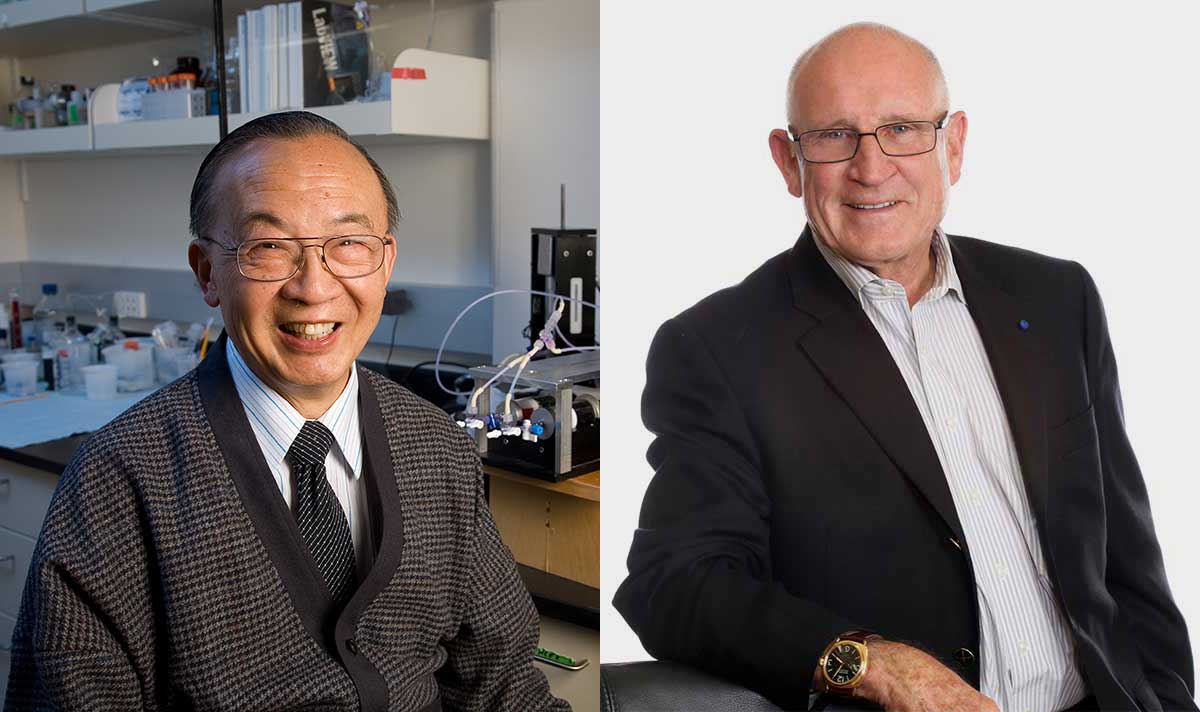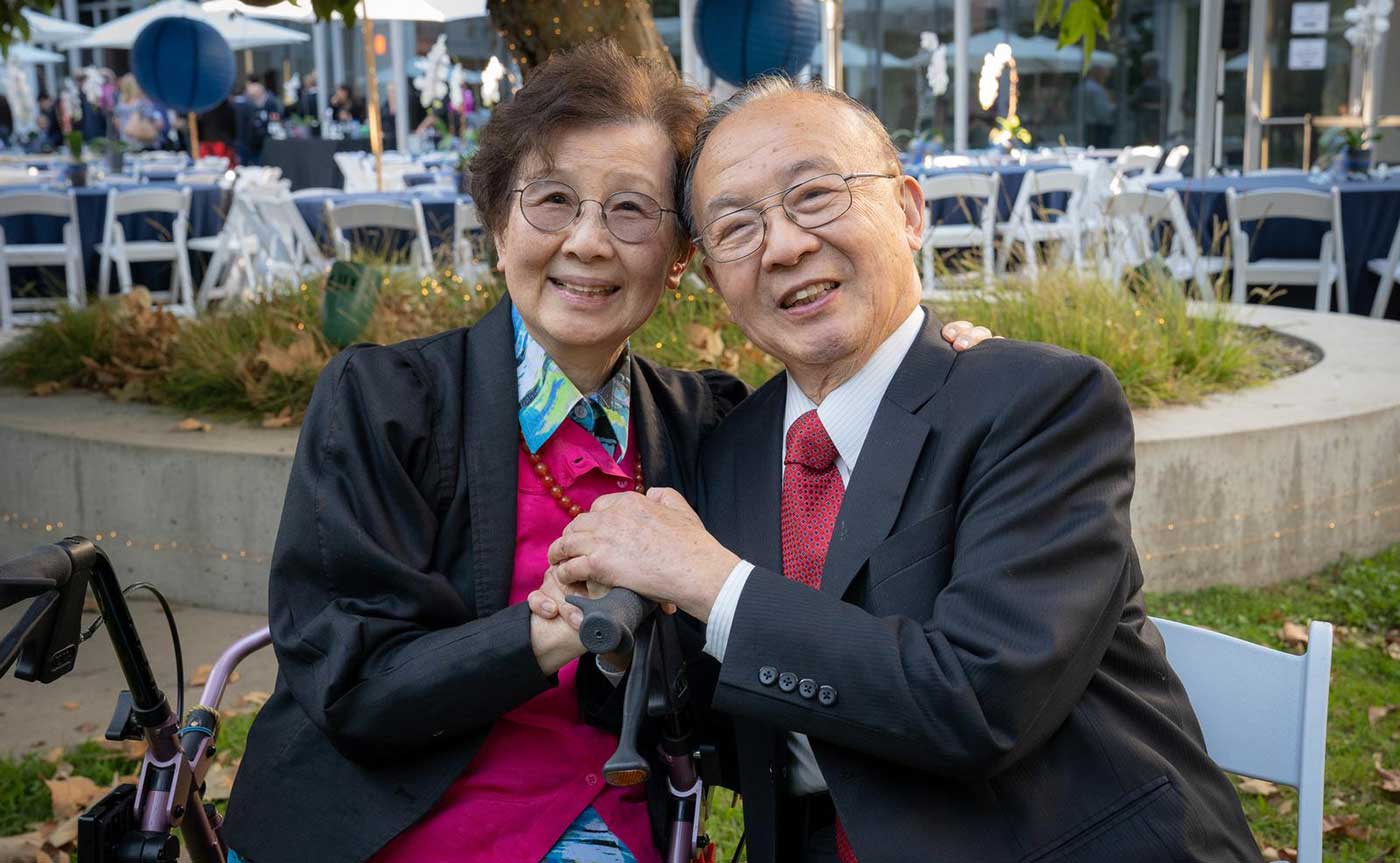
By:
- Katherine Connor
Published Date
By:
- Katherine Connor
Share This:

Titans of Industry, Academia Team Up to Advance Engineering in Medicine
Generosity of Shu and K.C. Chien and Peter Farrell to be recognized through named research collaboratory in Franklin Antonio Hall
When renowned UC San Diego bioengineer Shu Chien completed medical school in 1953, he wanted to find ways to make technological advancements in healthcare that would improve human lives. To do so, he had to find an engineer to collaborate with, since physicians and engineers were largely siloed professions at the time.
Peter Farrell, founder of sleep-disordered breathing medical device company ResMed, experienced something similar when completing his bioengineering Ph.D. research into treatments with the artificial kidney, working under the guidance of two advisors: one a nephrologist, and the other an engineer.
“Many years ago, if you talked to leaders in medical school about engineering, they’d say ‘Oh we’re not very interested in that,” said Chien. “But today, almost every major medical school leadership would like to have an engineering presence, and conversely leadership in engineering would like to have biomedical engineering complementation.”
Chien went on to earn a Ph.D. in physiology, and helped to create the engineering-meets-medicine world he was looking for as a young physician. The great success of his efforts are reflected in advances made by former students and colleagues around the world and right here at UC San Diego where the Bioengineering Department is ranked No. 3 in the nation according to U.S. News & World Report and No.1 according to the National Research Council of the U.S. National Academies.
Chien's research includes work critical to our understanding of how blood flows in the cardiovascular system. He is one of only a handful of individuals to be awarded the U.S. National Medal of Science and to be voted into all three National Academies (Science, Medicine and Engineering).
As founder of ResMed, Peter Farrell’s development of a machine that helps people with sleep apnea breathe better while asleep has transformed lives and led to greater understanding of the link between sleep-disordered breathing and chronic illnesses such as diabetes and hypertension. The concept of nasal CPAP (continuous positive airway pressure) was pioneered by Dr. Colin Sullivan at the University of Sydney Medical School to treat obstructive sleep apnea. Farrell came to the interface of engineering and medicine as an engineer. He is an elected member of the National Academy of Engineering, and served as founding director of biomedical engineering at the University of New South Wales, Sydney before becoming vice president of research and development at Baxter Healthcare, Japan.
Farrell was research and development vice president at Baxter for five years before founding ResMed, where he remains Chairman of the Board. ResMed sells 360,000 medical devices a month and 1.2 million masks of various types in more than 140 countries to treat sleep apnea, COPD and other respiratory conditions. ResMed is listed on the New York Stock Exchange (RMD) and employs 7,500 people.
Chien and Farrell agree that while the silos that once kept engineering and medicine as distinctly separate from one another have been breaking down, there is still room for improvement.
“Without engineering, medicine is just not going to advance at the level that it should,” said Farrell. “The participation of both fields is not only here to stay, it’s vital for healthcare in general. Engineers and physicians, pharmaceutical scientists and biologists all need to be working together, as a team. In the good programs, like UC San Diego, the silos have virtually disappeared.”
The UC San Diego Institute for Engineering in Medicine, which Chien founded, with Farrell sitting on the advisory board, is a prime example of how engineering and medicine have converged on campus. The Institute facilitates the integration of engineering principles and novel technologies with biomedical and translational research.
As the silos between engineering and medicine continue to dissolve, there is a growing need on campus for facilities where engineers, physicians and medical researchers can work in the same physical research ecosystems. Shu Chien and his wife, KC, recently joined forces with Peter Farrell to support this vision.

The Chiens and Farrell each recently donated $1.5 million to support programmatic expansion of engineering and medicine on campus. A large collaborative research facility for engineering and medicine in the Jacobs School’s newest building, Franklin Antonio Hall, will be named in recognition of their generosity.
The named Chien-Farrell Institute for Engineering in Medicine Collaboratory will serve as a hub for research at the interface of engineering and medicine. This collaborative research facility is one of 13 such "collaboratories" within the Jacobs School's newest building, Franklin Antonio Hall.
The Chien-Farrell Collaboratory will bring faculty, students, researchers and industry partners from different fields together in the same space, to facilitate the types of truly interdisciplinary, collaborative research required to solve society’s greatest challenges in medicine and healthcare.
“Today, one young person can get trained and have knowledge in all of these fields,” said Chien. “Nevertheless, one person cannot do as much as people collaborating together—we’re limited beings, so we still need a group to work together. That’s the beauty of interdisciplinary research: different people with different expertise mutually beneficial to each other. When we work together like this, the total of our efforts is much greater than the sum of each individual’s work.”
The Chien-Farrell Collaboratory in particular and Franklin Antonio Hall more generally will focus not only on collaborations among researchers from disparate fields, but among academic teams and industry partners as well.
“Entrepreneurship is not about risk taking, it’s about opportunity seeking,” said Farrell “Industry and academia all need to be part of the same ecosystem with the same goals. They support each other in a loop where the best ideas are fed into the marketplace to generate revenue, where a portion of the profit flows back to academia in research support coupled with potential equity. This new Collaboratory and Franklin Antonio Hall accelerate that loop, delivering good ideas which solve problems into the marketplace. Everybody benefits: it can help the campus, the students, society as a whole.”
“I'm really very honored to share the naming of the building with Peter,” said Chien. “He and his company Resmed have made tremendous contributions to the science and engineering of respiratory and sleep problems. I myself am a beneficiary of their product with sleep apnea, so I personally am grateful for that.”
“Shu is a pleasure to work with and a good guy to be involved with,” said Farrell. “He gets it. I have a lot of respect for him.”
Franklin Antonio Hall
In addition to the Chien-Farrell Collaboratory, 12 more of these large research facilities make up the heart of Franklin Antonio Hall. Each collaboratory will house a collection of professor-led research groups from different but related disciplines. Together, these complementary research teams will pursue grand-challenge research in areas like renewable energy technologies, smart cities and smart transportation, wearable and robotics innovations, and digital privacy and security. The building is designed to maximize the circulation and collaboration of UC San Diego faculty, students, professional research staff, and industry partners.
Franklin Antonio Hall will also serve as an important new facility for undergraduate and graduate-student learning, both inside and outside the classroom. The building will provide critical workspace for Jacobs School undergraduate student organizations that are participating in national design competitions. Teams of students will design, build and test their projects in this new collaborative environment. Teams will cycle through the space annually to best serve the growing number of nationally ranked student teams.
Franklin Antonio Hall is named after UC San Diego alumnus Franklin Antonio in recognition of his incredible $30 million gift to the UC San Diego Jacobs School of Engineering. The approximately 186,000 square foot university building is projected to be completed in early 2022.
Philanthropic gifts, like the gift from Shu and K.C. Chien and Peter Farrell, contribute to the Campaign for UC San Diego—a university-wide comprehensive fundraising effort concluding in 2022. Alongside UC San Diego’s philanthropic partners, the university is continuing its nontraditional path toward revolutionary ideas, unexpected answers, lifesaving discoveries and planet-changing impact. Visit the Campaign for UC San Diego website to learn more.
Share This:
You May Also Like
Stay in the Know
Keep up with all the latest from UC San Diego. Subscribe to the newsletter today.


